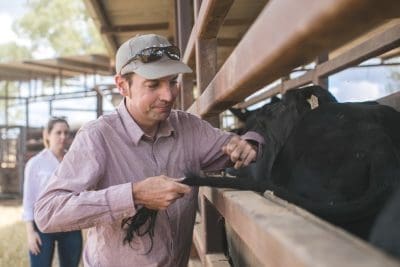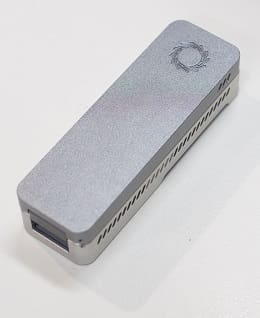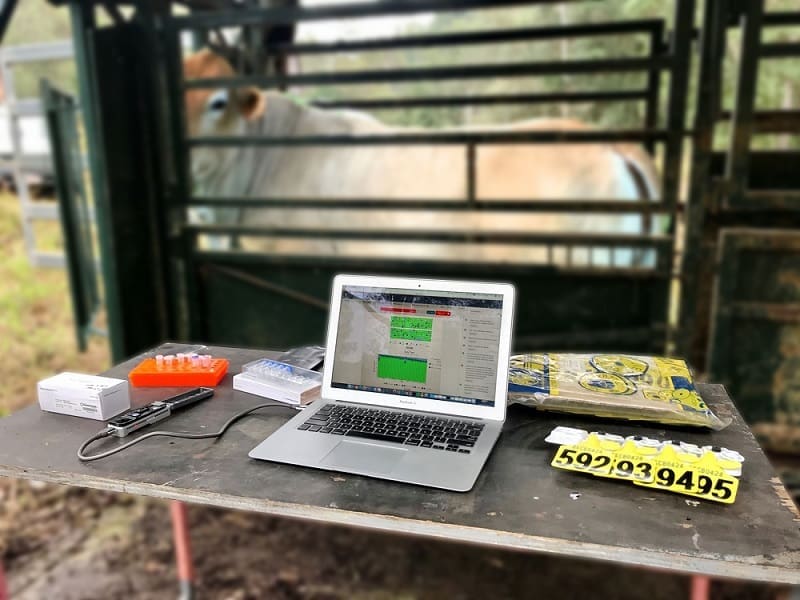
Analysing data with the MinION device
A NEW technology allowing the age of cattle to be determined by analysing a sample of their tail hair has been described as a “game changer” for Australia’s northern cattle industry.
University of Queensland researchers have developed the method that uses an existing real-time sequencing device to read the age of the animal from DNA extracted from the tail hair.
Up to now, the age of a beast has typically been determined by mouthing (dentition), ossification scoring in the carcase, or in some cases, a fire-brand numeral indicating year-of-calving.
Meat & Livestock Australia funded the project, which was supported by the Queensland Department of Agriculture and Fisheries and producers, to address a core issue affecting northern Australia’s beef industry – the inability to determine the age of individual animals.

Prof Ben Hayes taking a tail hair sample for DNA analysis from cattle near Rockhampton, Central QLD
The University of Queensland’s Centre for Animal Science director, Professor Ben Hayes said larger northern herds range freely in-between annual musters and the births of individual animals were generally not recorded.
“Without age records, it’s difficult to establish the baseline growth rates, apply genomic predictions, and there are also adverse impacts on herd management,” he said.
The work is being led by UQ Research Fellow Dr Elizabeth Ross using an Oxford-developed portable DNA sequencing device called MinION.
“The device is currently being used to give us information about the genetic makeup of the animal,” Dr Ross said.
“But we’ve discovered that it can also be used to accurately measure a cattle’s age to within 1.5 years.
“The DNA extracted for the animal’s tail hair using this method works across all ages in a herd, from five days to 14 years.”
Accuracy is expected to improve further as more data is collected.
The Northern Australia herd comprises 12.5 million cattle and makes up 90 percent of Australia’s live cattle exports.
Dr Ross said if adopted by producers, the technology can deliver both the age estimate and genomic predictions from the same DNA test and is a “game changer” for improving herd performance.
“There’ll be gains across the board for producers including improved herd fertility, growth rates, health, and meat traits,” she said.

Hand-held Minion DNA sequencing device
“Tools we can’t imagine today will be a reality in five years and I’m excited to be working with the portable DNA sequencer (pictured) to help the cattle industry prepare for future challenges.”
The team is now working to include hundreds more tail hair samples before taking the technology for proof-of-concept trials on cattle stations later this year, and Dr Loan Nguyen, who led the sequencing work, has developed protocols for several new studies.
As one of the inventors of genomic prediction, Professor Hayes said it was great to be able to help the Australian beef herd achieve significant productivity gains through this technology.
“This form of genetic analysis has proved exceptionally powerful at driving-up important productivity and welfare traits,” he said.
Meat & Livestock Australia’s general manager for research, development & adoption, Michael Crowley, said MLA supported the work because of the benefits that genomics can bring to the red meat industry.
“The performance data and DNA gathered from cattle will enable genomic predictions and this completes the feedback loop and making sure that industry data will be used to drive ongoing genetic improvement,” Mr Crowley said.
The genomics work is part of the Northern Genomics Project, which collected 23,000 DNA samples from 20,000 cattle across the top end. New DNA tools for the northern beef industry are being developed from this data.
The full study has been published in Frontiers in Genetics.

Genomic prediction testing on farm (c) Harry Lamb
Source: UQ
